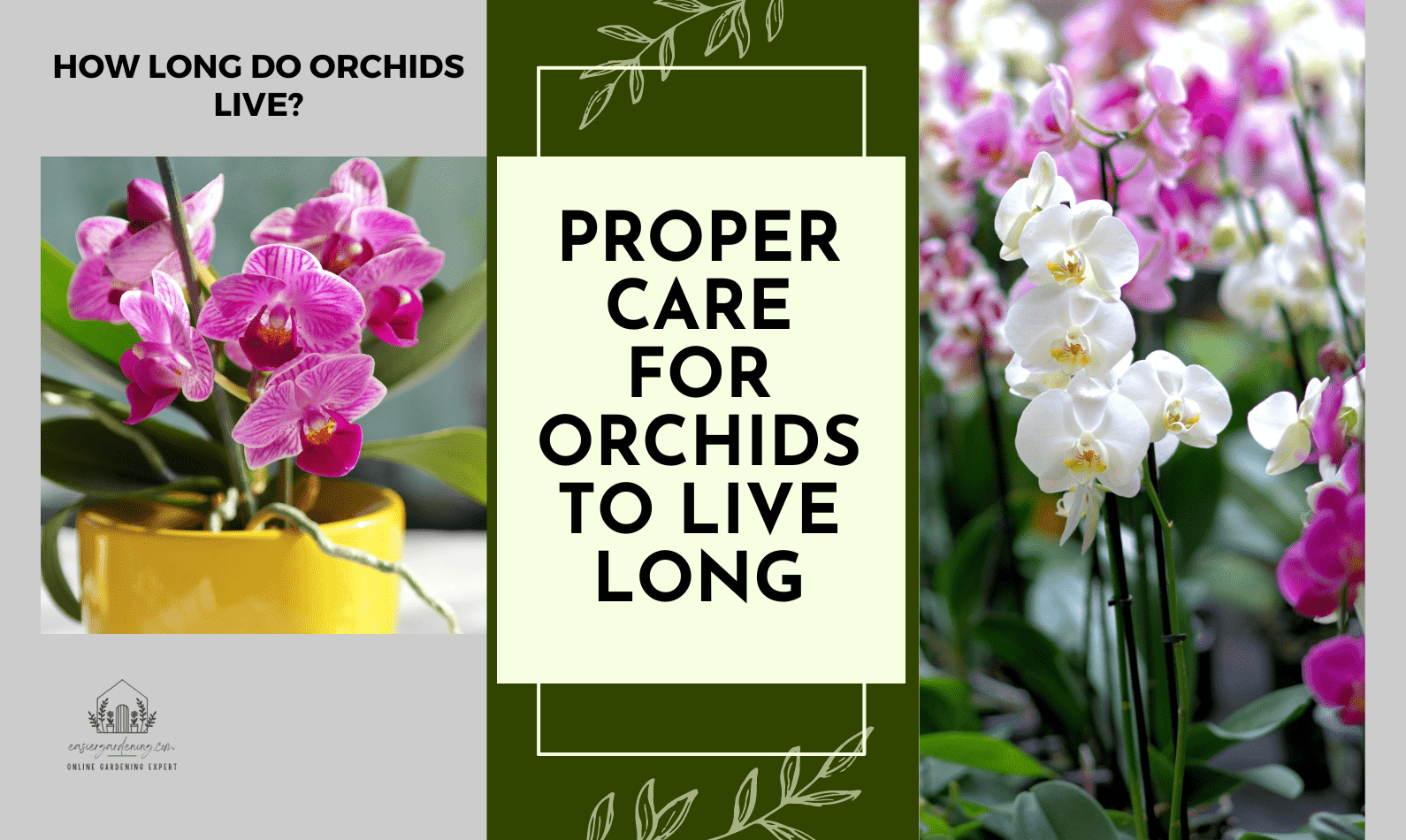How Long Do Orchids Live: How Can You Control It?: Orchids seem precious and exquisite. In autumn and spring, most of them make their grand entrance on the windowsill. But it is a common question mainly asked frequently by beginners that how long do Orchids live.
Contents
- How long do Orchids Live?
- How to Take Proper Care for Orchids to Live Long
- Location: Where to place Orchids?
- Temperature: The Best Temperature for Orchids?
- Fertilization: How to Fertilize Orchid?
- How Long can Orchids go without Water?
- How to Propagate Orchids Properly?
- Pruning
- Repotting
- How to Care for Orchids in Winter?
- Final Thought: How long do Orchids Live?
How long do Orchids Live?
With patience and a little luck, the plant can bloom a second time after the main flowering & survive for more years – if you water and care for it properly. Generally, Orchids can survive up to 20-22 years varying on different species.
After flowering, a rest period is important, during which the also plants need proper care so that they can gather strength for new flowering shoots. Especially waking up the plants towards the end of the rest period can be decisive for how lush the next flowering phase will be & how long they will live. In this article, we will demonstrate some tips & tricks to make your Orchids live longer.
How to Take Proper Care for Orchids to Live Long
If you ask, do orchids live forever? The answer is a ‘NO’. It doesn’t live forever. But to make sure that your planted orchids are going to survive for a longer period, you have to control certain things like-
- Location
- Temperature
- Fertilization
- Watering
- Propagation
- Pruning
- Repotting
Location: Where to place Orchids?
It is necessary to select the location where to place orchids. The location of orchids should be bright, but not under direct sun. Place the Orchid in a position with plenty of light, without direct sunlight. Too much sunlight will cause the plant to become duller in color and will do a lot of damage to the leaves. Also, this houseplant does not like drafts.
Temperature: The Best Temperature for Orchids?
To ensure proper orchid care, you should know the right orchid temperature tolerance. Orchids are uncompromising when it comes to temperature. They require a minimum temperature of 12°C to a maximum of 20°C. Under the shady canopy of large trees, even in tropical regions, the temperature does not rise above this, and if it does, orchids do not last, because at night the temperature drops again. Therefore, in the summer you can easily hang the orchid on a branch of a tree. In winter, it is somewhat more difficult to provide an orchid at the right temperature.
Fertilization: How to Fertilize Orchid?
Although orchids are very frugal plants, they have very high nutrient requirements when they bloom. During flowering, the orchid is also fertilized weekly with watering. To do this, you should only use an orchid fertilizer in liquid form. Liquid fertilizers can be absorbed more quickly by the plants, which in turn helps to maintain flowering. You can significantly extend the flowering period in this way. Proper fertilization is very necessary for determining how long do orchids live.
How Long can Orchids go without Water?
While the orchids are in bloom, you need to water them at least once a week. Do not use cold water from the tap, it should be at least room temperature. Also, orchids do not like chalky water, which can also lead to a shortened survival period. To water the plants, either immerse them in a tub for a few minutes or water them directly. However, water in the pot must be emptied afterward. It is very necessary to determine how much water does an orchid needs to make it live longer.
Tip: Every few weeks, you can also spray the leaves and aerial roots with water. However, this should only happen during the day, otherwise, they will take too long to dry.
How to Propagate Orchids Properly?
Proper propagation is very necessary for the orchids. This can happen either by the formation of a seed capsule or by the formation of a so-called pedicle at the inflorescence. Depending on the variety, it may also be possible to propagate only by seed. The popular variety, Phalaenopsis is easier to propagate via Kindel, while terrestrial varieties are more likely to form seeds.
In principle, however, propagation by seed is possible with any orchid, but pollination must be done by hand. Basically, propagation costs the plant a lot of energy, which means that the need for nutrients must be increased. During the removal, you should make sure that you cut away remnants of the inflorescence completely because remnants can begin to mold.
Pruning
For the plants to safely enter the flowering break, withered parts of the plant must be removed. This applies to inflorescences as well as aerial roots. In the dormant phase, the plants need their energy primarily to regenerate and form new plants for leaves and flowers. During this time, they are also particularly susceptible to diseases and pests.
A clean pruning of old plant parts prevents bacteria or pests from settling there, which can harm the plants. It is always important to use clean pruning tools for pruning. A sharp knife is ideal for this purpose. Scissors have the disadvantage that they can crush plant parts, which leads to tissue death.
Repotting
When orchids stop blooming, it is time to repot them. Repotting is a strong influencing thing in determining how long do orchids live. The procedure for repoting is as follows:
- Carefully remove the orchid from the pot.
- Shake off the old substrate.
- Check the health of the roots.
- Remove dried roots.
- Put the plant in a new pot with a new substrate.
- Immerse the plant for at least one hour.
After repotting, the orchid will not need any additional fertilization for about four weeks. In the coming resting phase, it is already sufficiently supplied with nutrients by the new substrate. How high the nutrient requirement afterward depends on when the plant enters the flowering break. In autumn and winter, the nutrient requirement is lower than when the plant is dormant in summer when faded plants can still better convert the fertilizer.
The same is true for watering. Although the intensity of watering is also reduced in the dormant period, again adapted to the season. In winter it is sufficient to water every three weeks, in summer increase the frequency to two weeks.
How to Care for Orchids in Winter?
Most orchids enter a flowering pause in autumn or winter. This time is ideal because at this time the temperatures are lower and there is less daylight. The end of the dormant period is determined by the orchid itself. As a rule, this period of regeneration lasts up to half a year. The end of the flowering pause is very easy to recognize because the plant begins to form new leaves and shoots. Along with this, you need to start fertilizing weekly again, so that the plant has enough nutrients.
You have to reduce the watering frequency & temperature at this time. When water and fertilizer are reduced, the orchid, like many other plants, starts its survival program. They are worried that they will not survive and still try to provide offspring in time, trying to create a new generation with a flower.
The lowering of the temperature at night, on the other hand, simulates a condition that many orchids find in their natural habitat. Even in tropical regions, there are seasons when temperatures drop significantly, at least at night. If you simulate this condition in your living space for several weeks, the orchid will usually start to produce new inflorescences. The advantage is that the simulated environment allows you to better control the time when orchids bloom again. The dormancy period can be extended and the orchid can be awakened at a better time, such as in spring.
Note: Orchids generally settle their rhythm after two to three years. However, it may happen that, the flowering break lasts up to a year.
Final Thought: How long do Orchids Live?
Orchids are the kinds of plants which, with proper care, you can enjoy the flowers for a long time. For that, you have to ensure the proper care for it. Only the proper care determines how long do orchids live. In this article, a detailed guideline for proper orchid care has been provided. If you have any further queries, please let us know through the comment section.


